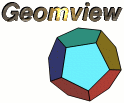 Home Overview FAQ Documentation Download Mailing List Geomview For Windows? Support Users Development Bug Reporting Contributing Contact Us Sponsors
|
[Date Prev][Date Next][Thread Prev][Thread Next][Date Index][Thread Index] geomview 1.1
To answer one of your questions:
>Is there anyway to normalize a group of objects the same way, or perhaps
>in a collection of objects, have all objects normalized the same way as
>the first object loaded? Currently, we have three objects - each color
>coded. We are not using any normalization because we want two of them
>imposed upon the other. The problem that occurs with this approach is
>that it makes it extremely difficult to rotate the three objects
>together to get the perspective we need.
Do you want to make a single combined object out of the three separate
objects you have right now? It would solve the normalization and
rotation problems referred to above. However, once you make a
combined object you lose the ability to interactively manipulate the
sub-parts. Often this is not desirable, but your message sounded like
perhaps this would be preferable for you.
There are two hierarchical file types, LIST and INST. A LIST is just a
collection of other objects; i.e. if you have files foo.quad,
bar.mesh, and bat.vect, you can combine them in the file all.list as
follows:
{ LIST
{ < foo.quad }
{ < bar.quad }
{ < bat.mesh }
}
If you want to specify positions for each of your separate objects,
you can make them into INST and then make a LIST from the three INSTs.
Here's an example where foo.quad and bar.quad are superimposed.
{ LIST
{ INST unit < foo.quad
transform 1 0 0 0
0 1 0 0
0 0 1 0
2 0 0 1
}
{ INST unit < bar.quad
transform 1 0 0 0
0 1 0 0
0 0 1 0
2 0 0 1
}
{ INST unit < bat.mesh
transform 1 0 0 0
0 1 0 0
0 0 1 0
0 0 2 1
}
}
|
||
|
Home | Overview | FAQ | Documentation | Support | Download | Mailing List Windows? | Development | Bug Reporting | Contributing | Contact Us | Sponsors |
|||
|
site hosted by |
|||